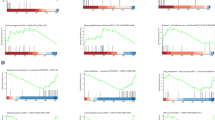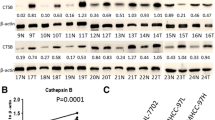Abstract
Matrix metalloproteinase-1 (MMP-1) is proposed to be involved in both tumor cell invasion and metastasis. MMP-1 proteolytically activates protease activated receptor-1 (PAR-1), which also plays an important role in tumor development and progression. However, it is currently unknown whether MMP-1 activation of PAR-1 has relevance to the progression of hepatocellular carcinoma (HCC). To address this problem, we investigate the clinicopathological and prognostic value of MMP-1/PAR-1 signaling axis in HCC. Immunohistochemistry assay was used to determine the expression of MMP-1 and PAR-1 proteins in normal and HCC tissues. The correlations of MMP-1 and PAR-1 expression with clinicopathological parameters were assessed by Chi-squared test. Patient survival and their differences were determined by Kaplan-Meier method and log-rank test. Cox regression was adopted for multivariate analysis of prognostic factors. MMP-1 and PAR-1 immunoreactivities were negative or low in normal liver tissues, but high in HCC tissues. PAR-1 expression was significantly correlated with that of MMP-1 (r = 0.896, p < 0.0001). The overexpression of MMP-1 and PAR-1 was significantly associated with recurrence, TNM staging and portal vein invasion of HCC. Patients with high MMP-1 and PAR-1 expression had significantly poorer overall survival (OS) (both P < 0.001) and disease-free survival (DFS) (both P < 0.001) when compared with patients with the low expression of MMP-1 and PAR-1. On multivariate analysis, MMP-1 and PAR-1 expression patterns were found to be independent prognostic factors for OS (both P < 0.001) and DFS (both P < 0.001). Our results suggest for the first time that the MMP-1/PAR-1 signaling axis might be applied as a novel marker for the prediction of recurrence and metastasis potency and a significant indicator of poor prognosis for patients with HCC.


Similar content being viewed by others

References
Farazi PA, DePinho RA (2006) Hepatocellular carcinoma pathogenesis: from genes to environment. Nat Rev Canc 6:674–687
Thorgeirsson SS, Grisham JW (2002) Molecular pathogenesis of human hepatocellular carcinoma. Nat Genet 31:339–346
Maheshwari S, Sarraj A, Kramer J et al (2007) Oral contraception and the risk of hepatocellular carcinoma. J Hepatol 47:506–513
Fan ST, Mau Lo C, Poon RT et al (2011) Continuous improvement of survival outcomes of resection of hepatocellular carcinoma: a 20-year experience. Ann Surg 253:745–758
Ko BS, Chang TC, Hsu C et al (2011) Overexpression of 14-3-3ε predicts tumour metastasis and poor survival in hepatocellular carcinoma. Histopathology 58:705–711
Gerstein ES, Sini L, Ryabov AB et al (2009) Comparative enzyme immunoassay of matrix metalloproteinases-2, -7, -9 and their tissue inhibitor-2 in tumors and plasma of patients with gastric cancer. Bull Exp Biol Med 148:899–902
Gialeli C, Theocharis AD, Karamanos NK (2011) Roles of matrix metalloproteinases in cancer progression and their pharmacological targeting. FEBS J 278:16–27
Schröpfer A, Kammerer U, Kapp M et al (2010) Expression pattern of matrix metalloproteinases in human gynecological cancer cell lines. BMC Canc 10:553
Nakopoulou L, Giannopoulou I, Lazaris ACh et al (2003) The favorable prognostic impact of tissue inhibitor of matrix metalloproteinases-1 protein overexpression in breast cancer cells. APMIS 111:1027–1036
Li Y, Jin X, Kang S et al (2006) Polymorphisms in the promoter regions of the matrix metalloproteinases-1, -3, -7, and -9 and the risk of epithelial ovarian cancer in China. Gynecol Oncol 101:92–96
Walker RA, Woolley DE (1999) Immunolocalisation studies of matrix metalloproteinases-1, -2 and -3 in human melanoma. Virchows Arch 435:574–579
Mroczko B, Groblewska M, Łukaszewicz-Zajac M et al (2009) Pre-treatment serum and plasma levels of matrix metalloproteinase 9 (MMP-9) and tissue inhibitor of matrix metalloproteinases 1 (TIMP-1) in gastric cancer patients. Clin Chem Lab Med 47:1133–1139
Hilska M, Roberts PJ, Collan YU et al (2007) Prognostic significance of matrix metalloproteinases-1, -2, -7 and -13 and tissue inhibitors of metalloproteinases-1, -2, -3 and -4 in colorectal cancer. Int J Canc 121:714–723
Yamashita K, Tanaka Y, Mimori K et al (2004) Differential expression of MMP and uPA systems and prognostic relevance of their expression in esophageal squamous cell carcinoma. Int J Canc 110:201–207
Okazaki I, Wada N, Nakano M et al (1997) Difference in gene expression for matrix metalloproteinase-1 between early and advanced hepatocellular carcinomas. Hepatology 25:580–584
Matsunaga Y, Koda M, Murawaki Y (2004) Expression of matrix metalloproiteinases (MMPs) and tissue inhibitors of metalloproteinases (TIMPs) in hepatocellular carcinoma tissue, compared with the surrounding non-tumor tissue. Res Commun Mol Pathol Pharmacol 115–116:143–150
Altadill A, Rodríguez M, González LO et al (2009) Liver expression of matrix metalloproteases and their inhibitors in hepatocellular carcinoma. Dig Liver Dis 41:740–748
Nierodzik ML, Karpatkin S (2006) Thrombin induces tumor growth, metastasis, and angiogenesis: evidence for a thrombin-regulated dormant tumor phenotype. Canc Cell 10:355–362
Chambers RC, Dabbagh K, McAnulty RJ et al (1998) Thrombin stimulates fibroblast procollagen production via proteolytic activation of protease-activated receptor 1. Biochem J 333:121–127
Fujimoto D, Hirono Y, Goi T et al (2008) Prognostic value of protease-activated receptor-1 (PAR-1) and matrix metalloproteinase-1 (MMP-1) in gastric cancer. Anticancer Res 28:847–854
Elste AP, Petersen I (2010) Expression of proteinase-activated receptor 1–4 (PAR 1–4) in human cancer. J Mol Histol 41:89–99
Gao L, Smith RS, Chen LM et al (2010) Tissue kallikrein promotes prostate cancer cell migration and invasion via a protease-activated receptor-1-dependent signaling pathway. Biol Chem 391:803–812
Hatfield KJ, Reikvam H, Bruserud O (2010) The crosstalk between the matrix metalloprotease system and the chemokine network in acute myeloid leukemia. Curr Med Chem 17:4448–4461
Grimm M, Lazariotou M, Kircher S et al (2010) MMP-1 is a (pre-)invasive factor in Barrett-associated esophageal adenocarcinomas and is associated with positive lymph node status. J Transl Med 8:99
Fang WL, Liang WB, He H et al (2010) Association of matrix metalloproteinases 1, 7, and 9 gene polymorphisms with genetic susceptibility to colorectal carcinoma in a Han Chinese population. DNA Cell Biol 29:657–661
García-López MT, Gutiérrez-Rodríguez M, Herranz R (2010) Thrombin-activated receptors: promising targets for cancer therapy? Curr Med Chem 17:109–128
Boire A, Covic L, Agarwal A et al (2005) PAR1 is a matrix metalloprotease-1 receptor that promotes invasion and tumorigenesis of breast cancer cells. Cell 120:303–313
Blackburn JS, Liu I, Coon CI et al (2009) A matrix metalloproteinase-1/protease activated receptor-1 signaling axis promotes melanoma invasion and metastasis. Oncogene 28:4237–4248
Zhang Y, Zhan H, Xu W et al (2011) Upregulation of matrix metalloproteinase-1 and proteinase-activated receptor-1 promotes the progression of human gliomas. Pathol Res Pract 207:24–29
Acknowledgements
This work was supported by the freedom explore Program (2011QNZT206) of Central South University and by a Lotus Scholars Program (200734) of Ministry of Hunan Province, P.R.China.
Author information
Authors and Affiliations
Corresponding author
Additional information
Mingmei Liao and Ping Tong contributed equally to this work.
Rights and permissions
About this article
Cite this article
Liao, M., Tong, P., Zhao, J. et al. Prognostic Value of Matrix Metalloproteinase-1/ Proteinase-Activated Receptor-1 Signaling Axis in Hepatocellular Carcinoma. Pathol. Oncol. Res. 18, 397–403 (2012). https://doi.org/10.1007/s12253-011-9458-8
Received:
Accepted:
Published:
Issue Date:
DOI: https://doi.org/10.1007/s12253-011-9458-8



